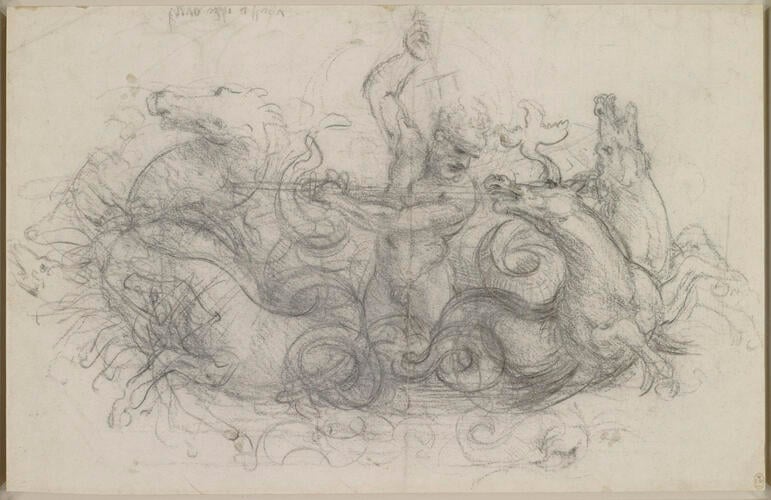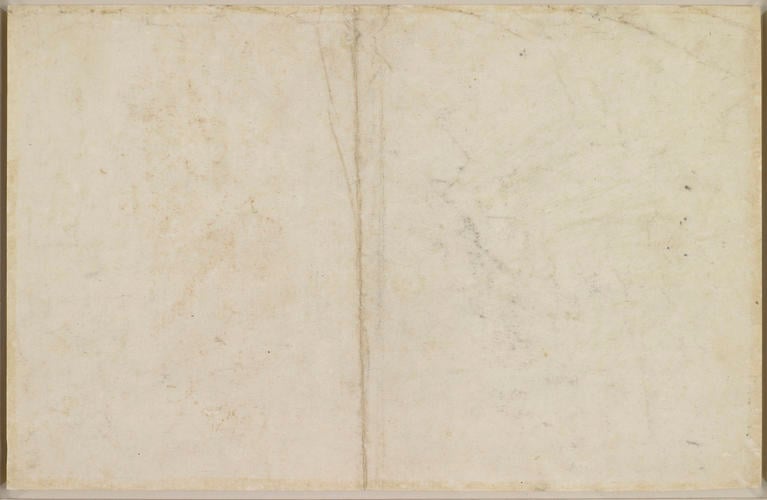-
1 of 253523 objects
Neptune c.1504-5
Charcoal | 25.1 x 39.2 cm (sheet of paper) | RCIN 912570
-
A drawing of Neptune, naked, seen from above the knees, holding a trident in his right hand. Around him are four sea-horses and tails of fishes. Above this is a note in Leonardo's handwriting: abassa ichavalli.
Leonardo spent most of the period 1500-08 in Florence. Among many other works, he executed a large finished drawing of the sea-god Neptune for his friend Antonio Segni, master of the papal mint. Giorgio Vasari described Leonardo's finished drawing as follows:
For his good friend Antonio Segni, [Leonardo] drew on a sheet of paper a Neptune, with such draughtsmanship and diligence that it seemed entirely alive. The sea could be seen churned up, and his chariot drawn by sea horses, with fantastic creatures, sea monsters and winds, and some beautiful heads of sea gods. The drawing was given by Fabio, his son, to Giovanni Gaddi, with this epigram:
’Pinxit Vergilius Neptunum: Pinxit Homerus
Dum maris undisoni per vada flectit equos.
Mente quidem vates illum conspexit uterque
Vincius ast oculis; jureque vincit eos.’
[Virgil and Homer both depicted Neptune driving his sea-horses through the rushing waves. The poets saw him in their imaginations, but Vinci with his own eyes, and so he rightly vanquished them.]
Antonio Segni had been appointed Master of the Papal Mint in 1497, though he did not reside permanently at the Vatican and travelled intermittently between Rome and his native Florence. He must have been an erudite collector, for Botticelli presented him with his Calumny of Apelles (Uffizi), and a friendship between Segni and Leonardo mentioned by Vasari would explain why the artist made such an exceptional drawing.
Segni’s Neptune is lost, and - strangely for a work that was famed during the sixteenth century - we have no certain record of it in a copy drawing or a print. A large drawing in the Accademia Carrara, Bergamo has been claimed as at least a partial copy of Leonardo’s design, and the upper part of Neptune and the horses to the right there are very similar to those here. But while the rough head of a dragon-like monster, of a type often drawn by Leonardo, is visible here at the centre left edge of the sheet, the Bergamo drawing does not include any of the sea creatures (other than Neptune’s horses) mentioned by Vasari.
This drawing, in which Neptune is seen from the thighs up, carries Leonardo’s rough note to himself to ‘lower the horses’. As has often been noted, an inspiration for Leonardo’s composition may have been a relief on a sarcophagus, then outside the church of Santa Maria in Aracoeli, Rome (and now in the Vatican), that shows Neptune standing thigh-length in a low boat drawn by four sea-horses breasting the waves and placed symmetrically at either side. The drawing must date from around 1504, when Leonardo was working on (among other projects) the composition of the Battle of Anghiari, which involves a comparable interweaving of man and horse; it is likely that Leonardo had visited Rome around the time, for in April 1505 he was reimbursed for customs duty on a parcel of his clothes sent from Rome.
Catalogue entry adapted from The Art of Italy in the Royal Collection: Renaissance and Baroque, London, 2007Provenance
Bequeathed to Francesco Melzi; from whose heirs purchased by Pompeo Leoni, c.1582-90; Thomas Howard, 14th Earl of Arundel, by 1630; Probably acquired by Charles II; Royal Collection by 1690
-
Creator(s)
Acquirer(s)
-
Medium and techniques
Charcoal
Measurements
25.1 x 39.2 cm (sheet of paper)

